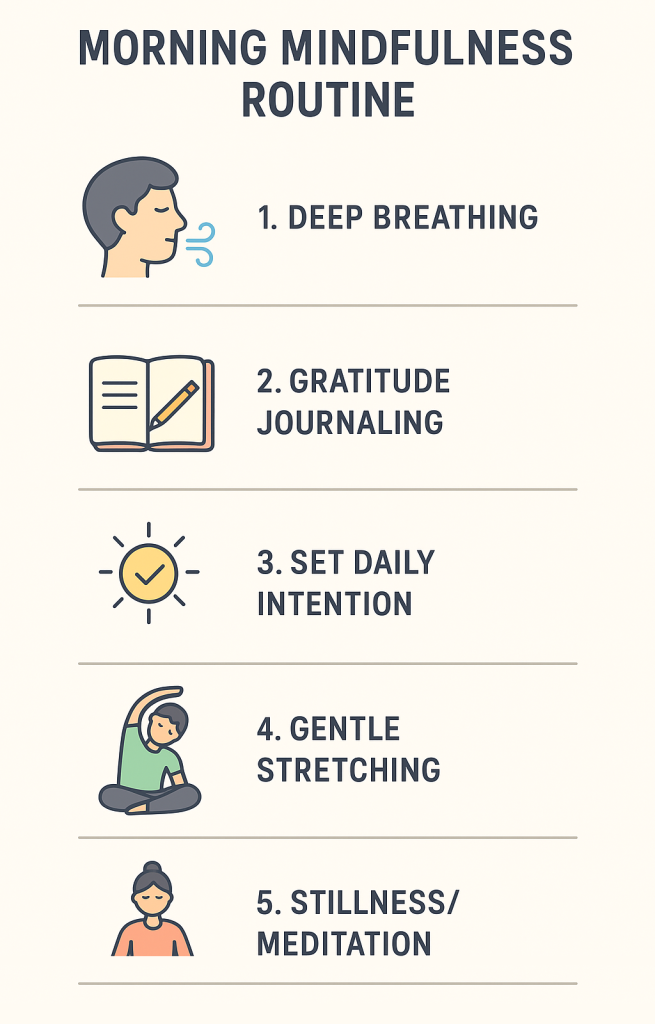The Perfect Morning Mindfulness Routine to Start Your Day
Most mornings, I used to roll out of bed, grab my phone, and dive head-first into a flood of notifications. By 9 AM, my mind felt like a browser with 27 tabs open — and I hadn’t even touched my to-do list.
Mornings set the tone for the rest of the day. If you start in a rush, chances are you’ll carry that stress into every task ahead. The truth is, your morning is your launchpad — and just a few mindful minutes can completely change your mood, focus, and energy levels.
Everything changed the day I decided to start with ten quiet minutes instead of a digital avalanche. This simple mindfulness routine isn’t about chanting on a mountaintop or buying fancy equipment. It’s a tiny shift that calms your mind, sharpens your focus, and sets you up to win the day — before breakfast.
With just 10 minutes routine, you can transform your mornings into a time of peace, focus, and intention. In this guide, you’ll learn a simple morning mindfulness routine that will help you feel grounded and ready for whatever comes your way.
The beauty of this routine lies in its balance — it’s short enough to fit into even the busiest mornings, yet powerful enough to shift your entire mindset for the day ahead. Many people abandon morning routines because they’re overloaded with tasks or require special tools, apps, or a long block of time.
This one strips away the complexity and focuses only on the most effective, science-backed practices: breathwork to calm your nervous system, gratitude journaling to boost positivity, intention-setting to guide your actions, gentle stretching to awaken your body, and a brief moment of stillness to strengthen focus.
Each step works together, creating a ripple effect that touches your mental clarity, emotional balance, and physical readiness.
The result? You step into your day feeling grounded, centered, and prepared — without adding stress or rushing through an endless checklist. It’s a routine designed not just to inspire you for a week, but to stick with you for years.
Routine Summary Table
| Step | Activity | Duration | Purpose |
|---|---|---|---|
| 1 | Deep breathing | 1 minute | Reduce stress & activate calm |
| 2 | Gratitude journaling | 3 minutes | Shift mindset to positivity |
| 3 | Set daily intention | 1 minute | Focus on a guiding principle |
| 4 | Gentle stretching | 3 minutes | Boost blood flow & energy |
| 5 | Stillness/meditation | 1 minute | Strengthen mindfulness |
Step 1 – Begin with Three Deep Breaths (1 Minute)
Before reaching for your phone, sit comfortably and close your eyes. Inhale slowly for four counts, hold for four counts, then exhale for six counts.
Why it works: Deep breathing lowers cortisol (the stress hormone) and signals your nervous system that you are safe and present.
Step 2 – Practice Gratitude Journaling (3 Minutes)
Write down three things you’re grateful for, no matter how small.
Example:
The smell of fresh coffee
A good night’s sleep
A supportive friend
Why it works: Gratitude shifts your brain’s focus from what’s missing to what’s abundant, creating an instant mood boost.
Tip: Keep a small notebook by your bed for easy access.
Step 3 – Set an Intention for the Day (1 Minute)
Choose one guiding intention such as “I will stay calm under pressure” or “I will speak kindly to myself.”
Why it works: Intentions act as mental reminders, helping you navigate challenges without losing focus.
Step 4 – Gentle Movement or Stretching (3 Minutes)
Flow through simple yoga poses like Cat-Cow, Forward Fold, or Child’s Pose.
Why it works: Morning movement increases blood flow, wakes up your body, and improves mental clarity.
Step 5 – One Minute of Stillness
End by sitting quietly, simply noticing your breath. If thoughts come, acknowledge them without judgment and return to your breathing.
Why it works: This strengthens mindfulness — the ability to stay in the present moment.
Benefits of Each Step
| Step | Mindfulness Benefit | Science-backed Reason |
|---|---|---|
| Deep breathing | Calms the nervous system | Lowers cortisol & activates parasympathetic response |
| Gratitude journaling | Improves mood & resilience | Trains the brain to notice positives |
| Setting an intention | Increases focus | Guides behavior and decision-making |
| Gentle movement | Boosts mental clarity | Improves circulation and oxygen delivery to the brain |
| Stillness/meditation | Enhances present-moment awareness | Builds neural pathways for focus & emotional control |
A Quick Recall
Bonus Tips for Success
Keep your phone on airplane mode until after your routine
Do it at the same time each morning to build habit strength
If you only have 3 minutes, just do Steps 1, 2, and 5
A morning mindfulness routine doesn’t have to be long or complicated. Even a few minutes can shift your mindset, boost your mood, and help you move through the day with greater clarity and calm.
The more consistently you practice, the more natural it becomes — and soon, it won’t feel like a “routine” at all, but simply the way you start your day.
Who Can Use This Routine and What They’ll Gain
| Type of Individual | Short-Term Benefit | Long-Term Benefit |
|---|---|---|
| Busy professionals | Reduced morning stress before work | Improved focus and productivity throughout the day |
| Students | Clearer mindset before classes or study sessions | Stronger concentration and better academic performance |
| Parents | Calmer mood before managing family duties | Greater emotional resilience and patience |
| Individuals dealing with anxiety | Immediate sense of grounding and calm | Better stress management and emotional stability |
| Creative professionals | Mental clarity for brainstorming and creative tasks | Sustained creativity and inspiration |
| Anyone new to mindfulness | Quick boost in mood and energy | Established daily habit that supports overall well-being |
FAQs
How long should a morning mindfulness routine take?
Most people find that 10 minutes is enough to gain the benefits without feeling rushed. You can start with 3–5 minutes and gradually increase as it becomes a habit.Do I need any special equipment for this routine?
No — this routine is designed to be done anywhere, without props. A quiet corner, a notebook, and comfortable clothing are all optional but helpful.What if I’m not a morning person?
You can still benefit from mindfulness at any time of day. However, doing it in the morning sets a calm and intentional tone that can positively influence everything you do afterward.Can this routine help reduce anxiety?
Yes. Deep breathing, gratitude, and meditation are proven to lower stress hormones and promote a sense of grounding. Over time, they can improve your overall emotional resilience.How soon will I notice results?
Many people feel calmer, more focused, and more positive immediately after their first session. Long-term benefits like better concentration and reduced stress typically build after a few weeks of consistent practice.
Sources & References:
Harvard Health Publishing – Mindfulness practice improves mental health
Greater Good Science Center – The Science of Gratitude








